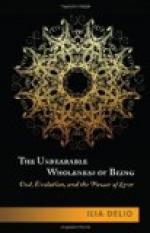The emotional life of both poets agrees fundamentally. They differ not so much in feeling as in thought and in faith. Dante possessed unshakable faith in the reality of his visions; eternal love in the shape of Beatrice was awaiting him; his vision was pure, eternal truth. The vision of Goethe, on the other hand, was poetic longing, tragical, because the vision of the transcendent came to the modern poet only in rare hours. Where Dante possessed, Goethe must seek, strive and err.
The deifying love of woman is, as we have seen, the extreme development of the second stage, in which sexual impulse and spiritual love are strictly separated, in which man despises and fights his natural instinct, or abandons himself to it—which is the same in principle—while his soul, worshipping love, soars heavenward. This dualism of feeling corresponds to the persistent dualism of Christianity and the whole mediaeval period. But as Goethe is frequently looked upon as a monist, my proposition that he was a dualist in eroticis will possibly be rejected, in spite of the fact that his emotional life is revealed to us with great lucidity. His first important work, his Werther, which is also one of the most important monuments of sentimental love, contains the germs of love as we understand it; the love which is no longer content to look upon sexuality and soul as two opposed principles, but strives to blend them in the person of the beloved. I will revert to Werther later on. This third stage, love in the modern sense, is programmatically established (as it were) in Elective Affinities, but all the rest of the very abundant evidence of his emotional life exhibits the typically dualistic feeling. Many of his early poems evidence sexuality pure and simple; in the Venetian Epigrams and in the Roman Elegies it is even held up as a positive value. In the third Elegy, for instance, the poet’s sensuality is linked directly to the famous lovers of antiquity, and everything which aspires beyond it is rejected. In the same way his West-Eastern Divan is characterised by a gay sensuality with homo-sexual tendencies.
The sensual quality of Goethe’s eroticism was partly spent in his relationship with Christiane Vulpius. The following passage, which forms an interesting counterpart to Goethe’s famous correspondence with Charlotte von Stein, is taken from a letter written to Christiane Vulpius during his absence from home. “The beds everywhere are very wide, and you would have no reason for complaint, as you sometimes have at home. Oh, my sweet heart! There is no such happiness on earth as being together.”




